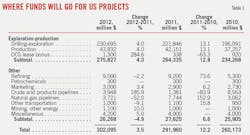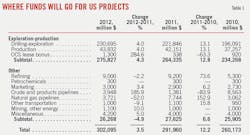Oil, liquids-rich shales dominate capital spending budgets for 2012
Capital expenditures for all oil and gas projects in North America will increase modestly this year, according to Oil & Gas Journal's annual spending outlook.
While upstream spending in 2012 will climb, the rate of growth will decelerate from a year ago. OGJ projects that total US capital spending for upstream, midstream, downstream, and corporate activities will increase by 3.5% this year to $302 billion following a 12% surge in spending during 2011.
The increase in upstream spending will be heavily weighted toward the development of oil and liquids-rich shales rather than dry gas production. The US is well supplied with gas, and prices are low enough to curtail investment in the short run.
Downstream capital spending will continue to be concentrated in Asia and the Middle East, where demand growth for oil products is strong. Oil and gas production from unconventional plays will drive US pipeline construction this year, and higher construction costs are giving a further boost to pipeline expenditures.
The near-month New York Mercantile Exchange natural gas futures price in the final quarter of 2011 averaged just $3.476/MMbtu and then dropped to average $2.708/MMbtu in January.
In contrast, oil futures averaged $94.06/bbl in the 2011 final quarter and then climbed to a January average of $100.32/bbl and higher in February.
OGJ finds that oil and gas capital budgets for development in Canada will climb by 3.6% this year, while Petroleos Mexicanos (Pemex) announced that its capital spending in 2012 for oil and gas activities in Mexico will increase by 6% from last year.
US upstream spending
Capital expenditures for upstream projects in the US will total $275.8 billion, up by 4% from last year's outlays.
This spending outlook is based on OGJ's forecast that a total of 43,800 wells will be drilled in the US this year, up from 42,120 wells drilled in 2011 and 37,892 wells drilled a year earlier.
Included in the 2012 total is an estimated $1.3 billion of Outer Continental Shelf bonus from an upcoming offshore lease sale.
The US Bureau of Ocean Energy Management will hold a consolidated central Gulf of Mexico lease sale in New Orleans on June 20. The sale, which will be the last during the 2007-12 US Outer Continental Shelf program, will include all unleased areas in the planning area off Louisiana, Mississippi, and Alabama (OGJ Online, Jan. 26, 2012).
Proposed OCS Sale No. 216/222 includes 7,250 unleased blocks covering nearly 38 million acres 3-230 miles offshore in 9-11,115 ft of water, BOEM said.
Last year, BOEM held one lease sale. Sale No. 218 on Dec. 14, 2011, offered 3,913 blocks in the western Gulf of Mexico. The sum of high bids from this sale was $337.7 million for the 191 blocks that received bids.
US firms' spending plans
Earlier this year Chesapeake Energy Corp. announced plans to sharply curtail its gas drilling activity in response to low gas prices (OGJ Online, Jan. 23, 2012). Chesapeake said it will reduce its dry gas drilling by 50% to about 24 rigs by the 2012 second quarter from an average of about 75 dry gas rigs used during 2011.
The Oklahoma City-based operator said its dry gas drilling expenditures in 2012 would decline to $900 million from $3.1 billion a year earlier. This would be the company's lowest such spending since 2005.
Meanwhile, Noble Energy Inc. plans this year to invest $1.25 billion in the Denver-Julesburg basin to expand its Niobrara horizontal drilling program and to spend $500 million in the Marcellus shale as part of the company's $3.5 billion capital budget (OGJ Online, Feb. 14, 2012).
Linn Energy LLC announced that its $880 million 2012 capital program will focus on oil and liquids-rich development. About 53% of this budget will be allocated to the Granite Wash to drill or participate in about 75 horizontal wells, 25% to the Permian basin to drill or participate in about 100 wells, 6% to the Bakken play area, and 6% to the Cleveland play area. The company said it will drill or participate in about 340 wells overall. The balance of the capital program will primarily focus on workover, recompletion, optimization, and facilities projects.
Hess Corp. announced a 2012 capital and exploratory budget of $6.8 billion, nearly all of which is targeted for exploration and production. Hess plans to spend $2.5 billion to develop unconventional resources in the Bakken, Eagle Ford, and Utica shales.
Further, Hess allocated $1.6 billion for production, $1.8 billion for development expenditures, and $800 million for exploration, which includes drilling exploration wells in Ghana, Indonesia, Brunei, and the deepwater Gulf of Mexico, as well as acquiring seismic data in Iraqi Kurdistan.
Refining expenditures
Most capital spending at US refineries, as it has been in recent years, will be allocated toward maintenance in 2012. OGJ sees total spending this year at $9 billion, down about 2% from last year.
Other than the construction of a new coker and hydrotreater at the BP PLC Whiting, Ind., refinery to increase its capability to process heavy Canadian crude, few major projects are planned at US refineries during 2012, according to OGJ's most recent Worldwide Construction Update (OGJ, Nov. 7, 2011, p. 28).
Dallas-based refiner HollyFrontier Corp. said in an analyst presentation that its 2012 capital expenditures would total $320 million, down from $340 million in 2011, with about $200 million of this year's budget going toward maintenance-capital outlays.
Valero Energy Corp., San Antonio, plans 2012 capital spending of $3.425 billion, with $185 million allocated for regulatory requirements, $560 million for turnarounds, $905 million for maintenance and reliability, and $1.775 billion for the completion of large economic growth projects.
Valero expects that its capital spending will decline sharply after this year, planning for merely what the company terms "staying in business" outlays for maintenance, turnarounds, and regulatory requirements.
Pipelines
Capital spending for crude and products pipelines in the US this year will surge, as plans call for the construction of 834 miles of these lines in 2012, according to OGJ's Worldwide Pipeline Construction report (OGJ, Feb. 6, 2012, p. 98). Expenditures, which include spending for compressor stations, will be $3.95 billion compared with outlays of $1.4 billion last year for the construction of 483 miles.
Kinder Morgan Energy Partners LP will build and operate a 136-mile line to transport gasoline, jet fuel, and diesel to an existing hub in Collins, Miss., from refineries in Norco, La. With an initial capacity of 110,000 b/d and the ability to expand to more than 200,000 b/d, Kinder Morgan expects the line to be in service by mid-2013 (OGJ Online, Sept. 16, 2011).
With its US Presidential Permit denied in January, TransCanada announced last month that it had moved its expected in-service date for the Keystone XL crude pipeline to early 2015—a 1-year delay from previous statements—and reiterated expectations that a reapplication for the would be processed in an expedited manner (OGJ Online, Feb. 15, 2012).
This year's capital expenditures for gas pipelines in the US will be $3.7 billion, with plans for the construction of 760 miles this year. Last year's spending for US gas lines was $7.7 billion, when plans called for the construction of 1,480 miles of such lines.
Spectra Energy Partners LP announced its estimated capital expenditures for 2012 of $30 million are for the completion of projects placed into commercial service in 2011, but the Houston-based company also seeks to expand its gas line to carry Marcellus gas to markets in New York, Connecticut, and Massachusetts. The Algonquin Incremental Market project has a target in-service date of November 2014.
Other US capital outlays
With most petrochemical plant projects currently under construction in Asia and the Middle East, capital spending at US petrochemical plants will remain at a minimum. Construction to produce petrochemicals is active in China, India, Qatar, Saudi Arabia, and the UAE, but OGJ forecasts that spending at such plants in the US this year will be unchanged at $300 million.
Miscellaneous expenditures, which include corporate facilities, information systems, cyber security, and other corporate activities, are forecast to total $4.2 billion this year, slightly higher than during the past 2 years.
While other transportation capital spending, which includes LNG, will slip this year, mining and other energy expenditures, including gas processing, will be up 10% to $1.1 billion.
Canadian E&P, oil sands
Total capital spending for oil and gas projects in Canada will be $67.8 billion (Can.). As in the US, this will be higher than during 2011, although the growth rate is reduced, and upstream development will be weighted toward oil rather than gas. Canadian expenditures during 2011 were up almost by almost 13% from a year earlier.
Expenditures for exploration, drilling, and production will increase by 3% from last year, totaling $43.3 billion (Can.) in 2012. This is based on the expectation that there will be 13,000 well completions in Canada, up from 12,600 last year. In 2010, there were 10,702 well completions, according to the Canadian Association of Petroleum Producers (CAPP).
In an outlook released in October 2011, CAPP estimated that 9,200 oil wells and 2,500 gas wells will be completed this year in Canada, with the remaining 1,300 wells being dry or suspended.
Capital spending for oil sands is expected to total $20 billion (Can.) this year, up from $19 billion (Can.) a year ago. CAPP reported that 2010 capital spending for oil sands was $17.2 billion (Can.), rebounding from the global recession's pullback that shrank 2009 expenditures to $11.2 billion (Can.).
In February, Calgary-based Imperial Oil Co. announced a $2 billion expansion of its Cold Lake situ oil sands operation in Alberta. The so-called Nabiye expansion is set to bring on additional commercial bitumen production of more than 40,000 b/d. Planned for startup by yearend 2014, the project will access 280 million bbl of recoverable reserves, Imperial said.
Suncor Energy Inc., which reported 2011 capital expenditures of $6.85 billion, plans 2012 capital spending of $7.5 billion, with an estimated $5.1 billion allocated for oil sands projects, including the expansion of Firebag Stage 4. Another $1.4 billion will be spent on E&P, while $600 million is directed toward refining and marketing.
Other Canadian spending
Based on plans outlined in OGJ's Worldwide Pipeline Construction report, which calls for 144 miles of gas lines to be constructed in Canada this year, capital expenditures for these lines and associated compressor stations will be $896 million (Can.). During 2011, such expenditures were $426 million (Can.) based on the construction of 149 miles at much lower costs.
Plans also call for 261 miles of products pipelines and 87 miles of crude lines to be constructed in Canada this year, bringing capital spending for these projects to $492 million (Can.), a decline of 34% from last year's spending for crude and products pipelines.
Refining expenditures will slump by 18% from a year ago to $1.4 billion (Can.), and petrochemicals outlays will be unchanged at $50 million (Can.) due to a lack of major projects. Other capital outlays in Canada, including LNG, marketing, and corporate expenditures, will post moderate increases from a year ago.
Spending in Mexico
Pemex reported that its planned capital expenditures for 2012 total $23.6 billion. This is up from 2011 spending of $22.2 billion and 2010 outlays of $20.4 billion. The company reported that 84% of this year's capital budget is to go toward upstream activities.
Pemex hopes to ramp up its production and exports of crude oil this year. In its 2012 guidance, the company projected that this year's oil production will average 2.56 million b/d, up from 2.55 million b/d in 2011. Exports are forecast to climb to 1.176 million b/d from last year's average of 1.149 million b/d. Gas production is projected to decline to 6.16 MMcfd from 6.52 MMcfd last year.
In January, Pemex published a call for bids for integrated service contracts to develop six areas to boost oil production by 90,000 b/d. This round, scheduled for June, follows a bidding round in 2011 that offered service contracts in three areas.
Major projects outside North America
Total SA announced that its 2012 budget for organic investments is $24 billion, with more than 80% dedicated to upstream development. This includes the ramp-up of Pazflor in Angola and the start-up of several major projects, including Usan in Nigeria, Angola LNG, and Bongkot South in Thailand. Exploration spending, pegged at $2.5 billion, is up 20% from last year.
In Australia, Inpex and Total have made the final investment decision for the massive LNG project at Ichthys, with total cost estimated to be $34 billion. Construction of the gas and condensate project, which will include two 4.2 million tonne/year LNG trains, a central processing facility for gas treatment, and a floating production, storage, and offloading vessel for condensate, is set to begin in this year's fourth quarter (OGJ Online, Jan. 13, 2011).
In January, Saudi Aramco and Sinopec Group signed an agreement valued at $8.5 billion for the joint construction and operation of a full-conversion refinery at the port city of Yanbu on the Red Sea (OGJ Online, Jan. 16, 2012).
As for another major project on the horizon, Indian Oil Corp. Ltd. let a contract to Foster Wheeler India PL for an LNG receiving terminal at Ennore in Tamil Nadu, India. The terminal will be designed to process 5 million tpy of LNG, with startup expected in 2015-16.
More producers' plans
Royal Dutch Shell PLC plans worldwide net capital investment of $30 billion during 2012. Shell has allocated 80% of this to upstream operations, and 60% of this upstream spending will be in North America and Australia.
In heavy oil worldwide, Shell is planning for $2 billion of 2012 spending, covering enhanced oil recovery, mining, and upgrading activities. Deepwater oil and gas spending in 2012 is set at $4 billion, with 250,000 boe/d of capacity under construction in seven projects spanning the Gulf of Mexico, Brazil, and Malaysia.
For downstream operations, Shell has $6 billion in investment planned for 2012, as commissioning is under way at its Port Arthur refinery expansion project. Shell also said it is looking at new manufacturing capacity options in North America, Qatar, and China, as well as selective growth in marketing activities and continued momentum in biofuels in Brazil.
Shell on June 6, 2011, announced a plan to build an ethylene cracker in the Appalachian region to process ethane from Marcellus shale gas.
Costing $3 billion, Shell's Prelude Floating Liquefied Natural Gas (FLND) project, set to come on stream in 2017 in Australia's Browse basin, will be the world's first floating liquefaction facility and the largest offshore structure ever built.
Meanwhile, BP PLC Chief Executive Officer Bob Dudley said he expects the group's organic capital spending will grow to $22 billion in 2012, up from 2011's $19 billion as BP invests in growth. He anticipates investment of $16–17 billion in upstream projects. Around $4.5 billion is expected to be invested in BP's downstream businesses, slightly higher than during 2011, as activity ramps up at BP's Whiting refinery upgrade.
BP's plans for this year include drilling 12 exploration wells, double the 2011 total, as well as starting six major upstream projects in higher-margin areas, operating with eight rigs in the US Gulf of Mexico by yearend, and continuing with its major divestment program.
Petroleo Brasileiro SA (Petrobras), in its 2011-15 investment plan, announced that it would spend $224.7 billion over the period. Of this total budget, $22.8 billion was allocated for exploration spending, and $104.7 billion was allocated for production outlays over the 5-year period.
The next-largest chunk of the spending was earmarked for refining, totaling $70.6 billion from 2011-15. The plan calls for $3.8 billion to go toward petrochemicals over the 5 years.
Petrobras says it can more than double production in the next decade with its 19 large projects that will add production capacity of 2.3 million b/d. Plans also call for drilling more than 1,000 offshore wells over the planning period: 40% exploratory and 60% for production development.
More Oil & Gas Journal Current Issue Articles
More Oil & Gas Journal Archives Issue Articles
View Oil and Gas Articles on PennEnergy.com
About the Author

Marilyn Radler
Senior Editor - Economics
Covers worldwide oil and gas market developments, creates forecasts, and compiles production and reserves statistics for Oil & Gas Journal. She joined OGJ in 1996 as Survey Editor. She holds a BA in Economics from the University of Texas at Austin. A Past President of the Houston chapter of the United States Association for Energy Economics, Marilyn currently serves as a USAEE council member.


